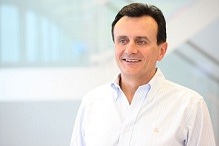 |
| AstraZeneca CEO Pascal Soriot |
AstraZeneca ($AZN) and its stilted R&D division aren't scheduled to move to Cambridge, U.K., until 2016, but the drugmaker can't wait to settle in at what it calls "one of the world's preeminent biosciences hotspots," planning to send an advance team of scientists to plant some collaborative seeds.
Starting next year, AstraZeneca will deploy about 400 R&D workers from its remote Alderley Park hub to set up shop at three temporary sites in Cambridge, including one already occupied by MedImmune. Those scientists will be tasked with getting the ball rolling on the company's plan to move away from rigid, inward-looking R&D and toward the en vogue cross-collaborative model, Executive Vice President Mene Pangalos said.
"Moving some of our scientists to Cambridge as early as next year will help cement the important relationships we are building with leading research, academic and healthcare organizations based in and around the city," Pangalos said in a statement.
Meanwhile, things are moving right along with AstraZeneca's planned $500 million Cambridge campus, designed to eventually host the company's R&D operations and corporate headquarters. The move is a central part of new CEO Pascal Soriot's plan to jump-start AstraZeneca's sluggish pipeline, following a long-standing trend of drug developers ditching suburban office parks and cozying up to universities, medical centers and other biotech innovators. Among AstraZeneca's soon-to-be neighbors are the University of Cambridge School of Clinical Medicine, Addenbrooke's Hospital and the Cancer Research UK Cambridge Institute.
"Moving to the Cambridge Biomedical Campus means our people will be able to rub shoulders with some of the world's best scientists and clinicians carrying out some of the world's leading research--that's a really exciting prospect," Soriot said in June.
But, however exciting, the move is still three years away, and AstraZeneca will need to derive some ingenuity from its current setup in the near term. The drugmaker has bought its way into triglycerides and COPD, picking up Phase III assets from Pearl Therapeutics and Omthera, but after a string of late-stage failures, AstraZeneca's in-house pipeline is wearing thin. And Crestor, the company's cardiovascular workhorse, loses U.S. exclusivity in 2016, just in time for some Cambridge-bred innovation.
- read the statement